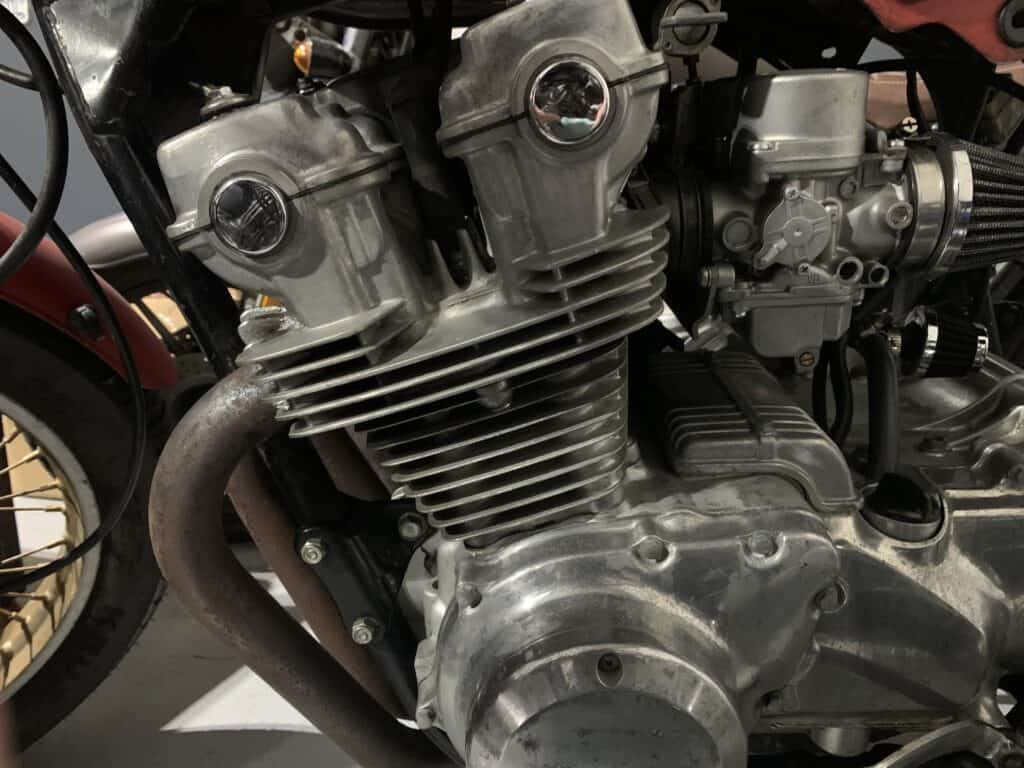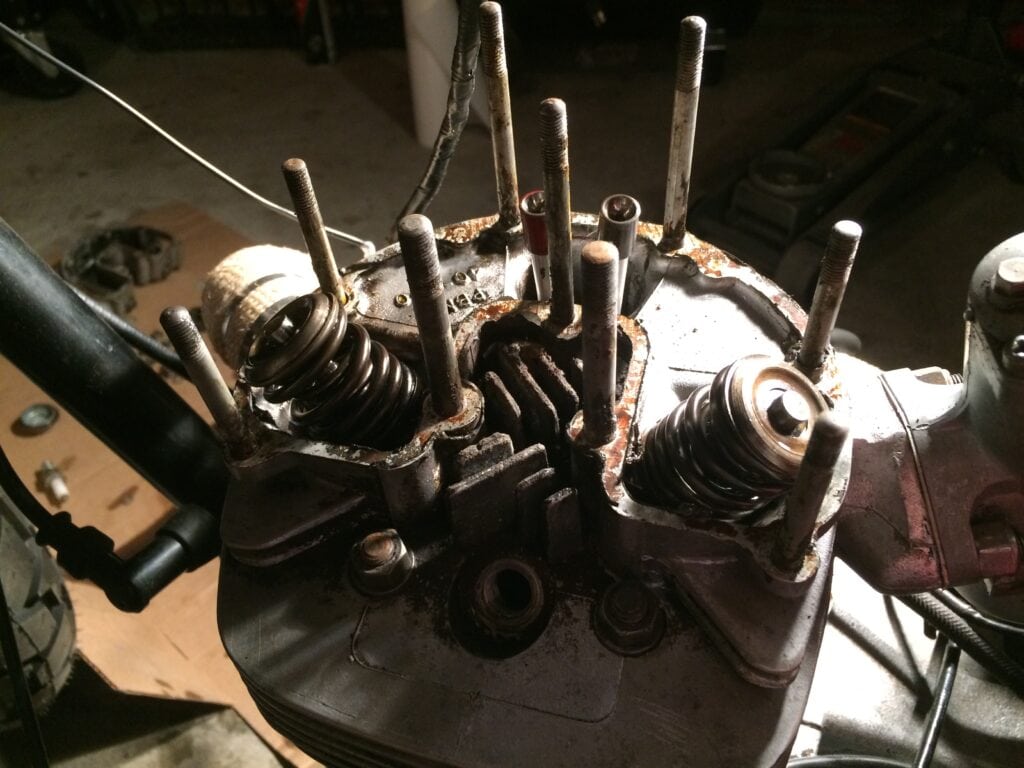
Whether you own a motorcycle or a car, you have probably heard the term “blown head gasket”. It’s a term that is generally known, but most people don’t know exactly what it means and what implications it can have.
Can you ride a motorcycle with a blown head gasket? It is advised that you do not ride a motorcycle with a blown head gasket unless the situation is emergent. Riding a motorcycle in such a condition can lead to engine failure since there in not proper pressure in the combustion chamber as well as improper lubrication.
When it comes to engine problems, motorcycle riders should be promptly attentive because it has a direct effect on your personal safety and other drivers around you. This article will help you understand what you can do about your blown head gasket on your motorcycle, how to tell if you’re dealing with a blown head gasket, and ways to prevent getting a blown head gasket in the first place.
Riding With A Blown Head Gasket
Your head gasket performs a very critical function on your motorcycle. It serves as a seal between the cylinder head and the engine block. This seal allows coolant to flow through small engine passages and for oil to flow around all the moving parts for lubrication. It also seals the combustion chamber itself.
The head gasket can “blow” as you will often hear. This means that the seal is now broken. This can allow your oil and coolant to mix. It also can affect the pressure inside the combustion chamber which can affect your piston performance and combustion efficiency. All of these things can be absolutely catastrophic to your engine and destroy it in seconds. That is why it’s important that you don’t ride with a blown head gasket unless it is absolutely necessary.
What can actually cause your head gasket to blow? The most common cause is temperature. If your engine gets too hot, this can cause serious problems to your head gasket. The extreme temperature can cause your gasket to warp as a result of the thermal expansion of the gasket material. If the gasket changes shape at all, you can lose your ability to seal properly.
A blown head gasket can completely dismantle the internals of your engine instantly. It is impossible to predict when it will fail on you, so it is best to always repair a blown head gasket before riding around anymore. This can save you thousands of dollars down the road.
There are several things that you may experience if you try to ride around with a blown head gasket, the first being smoke. Once your head gasket has blown, you will start experiencing white-grayish smoke coming from the exhaust pipes. Depending on how bad the head gasket leak is, this could be a small amount of smoke or huge billowing clouds of smoke.
The exhaust fumes turn white-grayish because coolant is mixing into the gases in the combustion chamber and igniting with the gas/air mixture. When coolant is burned it gives off white-grayish smoke.
The amount of smoke coming from your exhaust can also change in an instant. This also becomes a safety hazard for those around you as huge clouds of smoke will also impair the vision of other drivers. And we all know, other drivers being able to see you is the most critical safety factor of riding a motorcycle.
When you are riding your motorcycle with a blown head gasket, it is critical that you keep a very close eye on your engine temperature. As coolant leaks into the combustion chamber and mixes with your oil, you very quickly can run low on coolant. As a result, the engine temperature can creep up fairly quickly.
If the engine temperature gets too high, it can cause irreversible damage that can result in the need for a new engine. If your motorcycle does not use coolant and is air cooled, the risk is still high since oil is likely leaking which leads to poor lubrication inside the engine.
Again, the best-case scenario is not to ride your bike at all when it has a blown head gasket. If you absolutely have to, keep a very close eye on the temperature gauge as this may save the life of your motorcycle.
How To Tell If The Head Gasket Is Blown
As previously explained, one sign that you have head gasket problems is seen by the engine temperature. If your engine temperature suddenly is increasing unexpectedly, it very likely could be your head gasket. You may be trying to cool your bike with much less coolant than before.
Another key sign is smoke. You may notice quite a bit of smoke coming from the exhaust. This is a sign that engine oil or coolant has now started entering the combustion chamber. Based off of what exactly is in the combustion chamber, the color of the smoke can change.
Generally, you will see a white or grey cloud of smoke. If you are burning oil in the combustion chamber you will also experience blue smoke. The sudden appearance of smoke is a key sign to keep an eye out for so that you are aware if your head gasket has blown or not.
Another sign to be on the lookout for is a sudden loss of power. As your motorcycle no longer will be able to hold the same level of compression inside the engine, it’s efficiency will decrease. You will notice that you no longer have as much power and that you are not getting as good of fuel economy.
You may even have some sputtering as the compression is too low. If you experience any of these signs suddenly while riding, it is important that you find out quickly whether it is the head gasket or not.
If you see oil pooling up somewhere on the engine block, that could also be an indication that the head gasket has blown and oil is seeping through that hole on to your engine.
The last sign to check for is discolored oil. If coolant begins to mix with your oil, it can very quickly start to change the color of the oil. Your oil’s ability to lubricate the engine will decrease significantly. If you have oil mixed with coolant, the mixture will become a brown color similar to chocolate milk. If you see your oil looking like this at all, it’s important that you quickly get the head gasket repaired and also get your oil changed.
How To Fix A Blown Head Gasket: Is It Worth The Cost?

It is always worth the cost to repair your blown head gasket. Head gasket repairs can be very pricy which encourages riders to avoid fixing the issue if the motorcycle still runs. A head gasket repair at a reputable shop can cost you anywhere from $1400-$2500 USD. While this may sound like a lot, replacing the entire engine can cost you twice as much.
You can replace your own head gasket for $100-$200 USD. In order to get to the head gasket, you will first have to remove the top part of the engine. This includes your exhaust headers and also your fuel tank. There could be other objects in your way based off the model of your bike.
Next, you will need to loosen the cylinder head bolts. This will allow you to remove the cylinder head itself. From there you can take off the old gasket. Be sure to entirely remove the gasket and clean the surfaces. Next you can install your new gasket and be sure to follow all manufacturer procedures. Place it on the sealing surface and put the cylinder head back on.
Reassemble everything that you had to take off in order to get to the head gasket. Once you have everything put back together, it’s important that you verify that you are now sealing properly. You may even need to run compression tests to make sure that the engine is working as it should now.
I’m all about saving money and learning how to do things myself, but I only recommend trying to replace the head gasket yourself if you have the help of someone who has done it before.
I purchased a 1980 Yamaha XS850 to restore it and sell it for a profit. I quickly learned after I bought it that it had a blown head gasket (I know I know, I learned my lesson!). Luckily someone was selling the exact engine I needed, so I just swapped out the engine for $200. I got lucky, changing out the head gasket would have been a pain!
How To Prevent A Blown Head Gasket On A Motorcycle
The number one thing that you can do to prevent a blown head gasket is to watch your engine temperature. If the engine ever gets too hot, you can quickly ruin your head gasket. Always be conscious of your engine temperature especially when riding in very hot weather or while in heavy traffic. Overheating the engine is a quick and easy way to destroy it.
Not only can the head gasket itself deform from the material thermal expansion, but the cylinder heads can also permanently deform from excess heat. If either of the cylinder head or head gasket shape is changed from the temperature, your ability to seal around the engine will be gone.
Different materials have different coefficients of thermal expansion. Depending on what materials are used, they will react differently to temperatures. For example, steels will expand less with temperature than aluminum. This is important as many engines are made from aluminum.
As a final note, just remember that regular maintenance is the most important factor in the overall health of your motorcycle. Checking the oil, glancing at the engine temperature while riding, paying attention to exhaust color, and noticing a loss in power can save you thousands of dollars in the long run.
Conclusion
While it is still technically possible to ride a motorcycle with a blown head gasket, I highly suggest you don’t since it can easily lead to catastrophic damage to your engine. A blown head gasket means less pressure inside the combustion chamber and a higher risk of oil and coolant mixing. Even if your motorcycle is air cooled, this leads to oil leaking which means less lubrication for the engine internals.
Routine maintenance and keeping an eye on engine temperature are the best things you can do to prevent a blown head gasket on your motorcycle. Have you guys ever had a blown head gasket on your motorcycle? Tell us what your experience was like!
